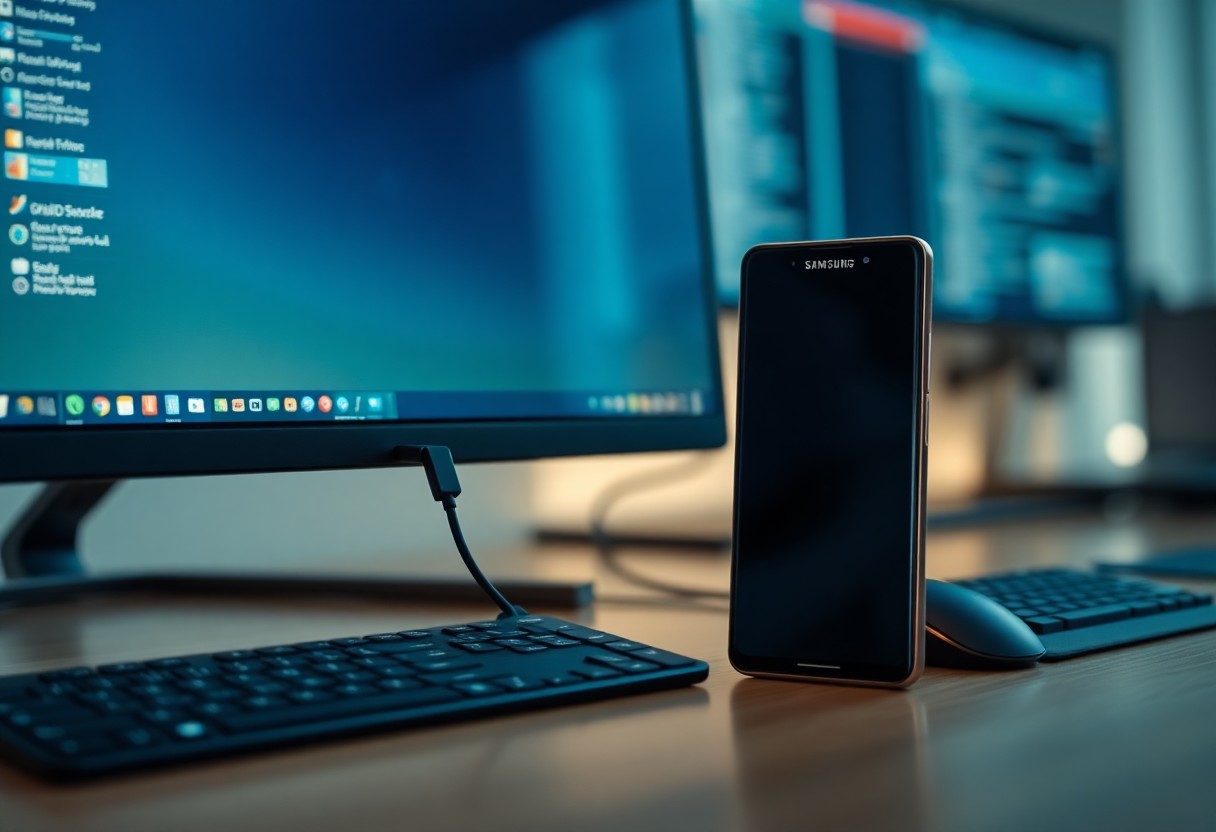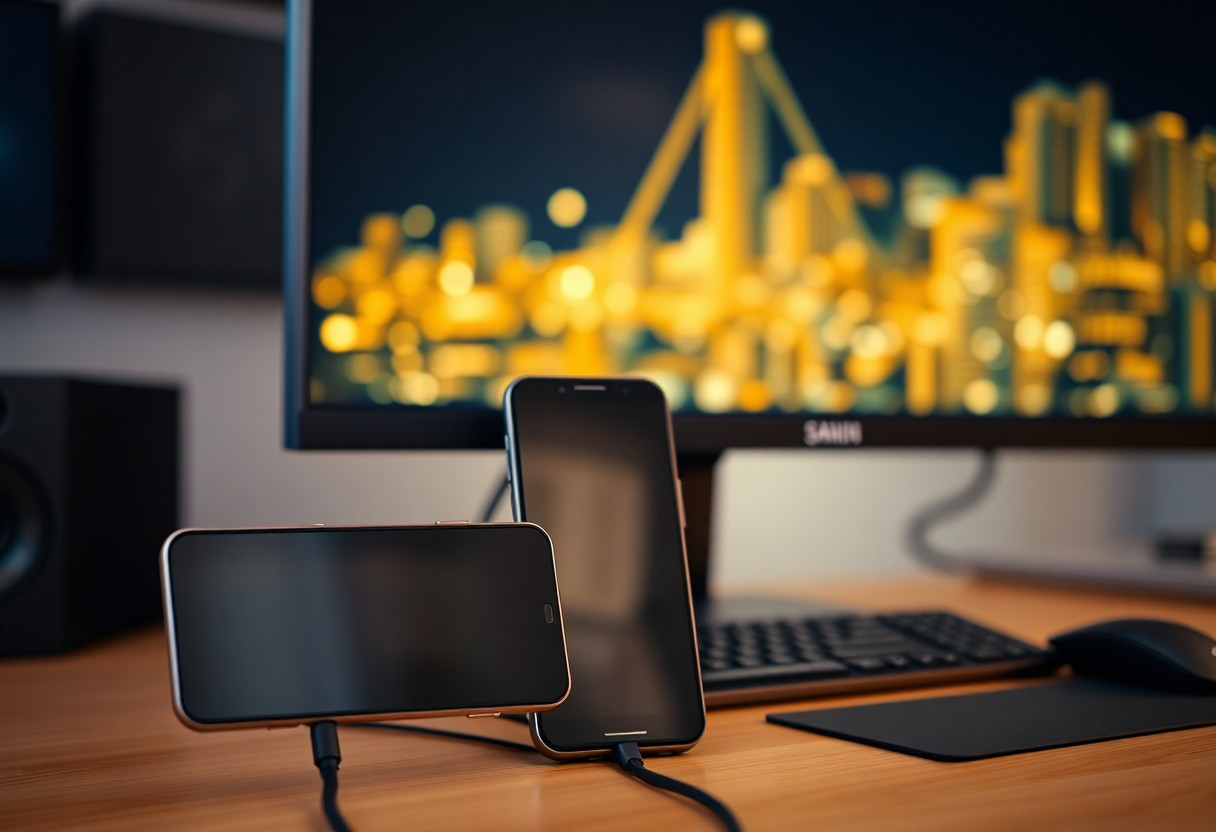Many people wonder if they can connect their Samsung phone to a monitor for a larger viewing experience or enhanced productivity. The good news is that you can easily do this using a variety of methods, depending on your phone model and the monitor you have. Whether you want to share photos, give presentations, or play games on a bigger screen, connecting your device can transform your digital experience. In this post, we’ll guide you through the steps needed to make this connection seamless and effective.

Key Takeaways:
- You can connect your Samsung phone to a monitor using various methods, including HDMI adapters or wireless casting options like Smart View.
- Ensure your monitor supports the appropriate input connections and your phone has the necessary features, like DeX mode, for a seamless experience.
- Once connected, you can enjoy a larger display for multitasking, gaming, or streaming content from your phone.
Understanding the Basics
For anyone looking to enhance their smartphone experience, connecting your Samsung phone to a monitor offers a broader display and improved productivity. Whether for gaming, work, or media consumption, this connection can significantly elevate how you use your device. Understanding the basics will ensure you make the most of this functionality and have a seamless setup.
Types of Connections
- HDMI – A widely used option for connecting devices.
- USB-C – Modern phones often utilize this connection for video output.
- DisplayPort – A high-performance connection for enhanced graphics.
- Wireless – Options like Miracast allow for cable-free setups.
- MHL – An older standard still found on some devices.
Thou may find these options appealing depending on your existing equipment and preferences.
| Connection Type | Description |
| HDMI | Common and easy to use. |
| USB-C | Efficient and supports high-quality video. |
| DisplayPort | Great for high-resolution displays. |
| Wireless | Convenient option without cables. |
| MHL | Older but still compatible with some devices. |
Required Adapters and Cables
Below, understanding the specific adapters and cables you need is imperative for a successful connection. Depending on the type of display and your phone model, having the right accessories can simplify the process and enhance your overall experience.
The adapter or cable you choose can greatly affect the performance and functionality of your setup. For instance, using a high-quality HDMI cable ensures that you achieve the best possible video quality. If your phone has a USB-C port, a simple USB-C to HDMI adapter will allow you to connect easily. Always verify compatibility to prevent any issues. Also, beware that some cheap cables may compromise your signal quality, leading to display issues. Always opt for trusted brands for your adapters and cables.
Preparing Your Samsung Phone
There’s no need to worry about connecting your Samsung phone to a monitor; it just requires a few simple steps. First, ensure that your device is ready for the connection by checking compatibility and enabling specific settings. In doing so, you’ll maximize the experience of extending your phone’s display to a larger screen.
Checking Compatibility
With various Samsung phone models available, you need to verify that yours supports external display connections. Most recent models are equipped with this feature, but specific older or budget models might lack the necessary capabilities. Consult your user manual or Samsung’s official website to confirm your device’s compatibility.
Enabling Developer Options
Enabling Developer Options on your Samsung phone is a straightforward process. Go to your device’s Settings, scroll down to “About phone,” and tap on “Software information.” Then, tap on the “Build number” seven times. You’ll see a prompt indicating that Developer Options are now enabled. This allows you access to additional settings necessary for a smoother connection.
Understanding the Developer Options may help enhance your user experience, but be cautious. While these settings offer useful features for developers and advanced users, some adjustments could inadvertently affect your phone’s performance. Utilize these options wisely and only adjust settings you clearly understand. Always revert any changes if you experience issues, ensuring your device remains stable.

Connecting to a Monitor
To connect your Samsung phone to a monitor, you can use various methods that maintain a stable and high-quality display output. Regardless of your choice between wired or wireless options, it’s important to ensure compatibility with your monitor for the best experience. Follow the appropriate steps to initiate the connection effectively.
Wired Connection Methods
Methods like HDMI and USB-C connections are popular for linking your Samsung phone directly to a monitor. For an HDMI connection, use a compatible USB-C to HDMI adapter, which allows for direct video and audio transmission. Ensure your monitor is set to the correct input source to view your phone’s display.
Wireless Connection Options
Monitor your Samsung phone’s display wirelessly using technologies like Miracast or Smart View for seamless screen sharing. To initiate a wireless connection, access the settings menu on your phone, select the display option, and choose the monitor from the available devices.
And while using wireless connection options can enhance your convenience, be aware that they may occasionally result in lag or reduced quality compared to a wired connection. Ensure your Wi-Fi network is stable to minimize disruptions. Additionally, always check compatibility between your Samsung phone and the monitor to prevent connectivity issues, making your experience smooth and enjoyable.
Configuring Display Settings
After connecting your Samsung phone to a monitor, the next step is configuring the display settings for optimal performance. You can navigate to your device’s settings by accessing the display options, which will allow you to choose the mode that best suits your needs, whether it’s screen mirroring or using it as an extended display. This configuration ensures a seamless experience while using multiple screens.
Screen Mirroring vs. Extended Display
Below you’ll find an overview of the differences between screen mirroring and extended display. Screen mirroring duplicates your phone’s screen on the monitor, making it ideal for presentations or watching videos. In contrast, extended display allows you to use the monitor as a second screen, giving you the capability to multitask by dragging apps and windows between your phone and monitor.
Adjusting Resolution and Orientation
Mirroring your device’s display can come with some nuances, particularly in resolution and orientation settings. You may find that the resolution does not automatically adjust to fit your monitor, which could affect the clarity of the content. You can change the screen orientation to portrait or landscape mode based on how you want to view your applications.
Due to varying resolutions among monitors, it’s important to adjust your settings to prevent distortion and ensure optimal visibility. Go to the display settings on your Samsung phone to select the appropriate resolution that matches your monitor’s native resolution. This will enhance your viewing experience. Moreover, adjusting orientation can help align your content appropriately for what you’re working on. A quick tweak can make a significant difference in usability.
Troubleshooting Common Issues
Many users encounter issues when connecting their Samsung phone to a monitor. Common problems include poor display quality, lag, and connectivity failures. This section will help you diagnose and resolve frequent issues that may arise, ensuring a seamless connection between your devices.
No Signal Problems
One common issue you might face is the ‘No Signal’ error on your monitor. To troubleshoot this, check if your monitor is powered on and properly set to the correct input source. Also, ensure that the cable connecting your phone to the monitor is firmly attached and not damaged.
Connectivity Errors
By reviewing your connection method, you may identify specific connectivity errors. Ensure you are using compatible cables and adapters, as mismatched or faulty accessories can lead to failure in establishing a connection.
But if you still face issues, it could be due to incompatible cables or a faulty adapter. In some cases, updating your phone’s software may resolve underlying issues causing connectivity errors. Additionally, checking for any interference from other wireless devices could be beneficial. Always ensure your devices support the necessary ports and standards to avoid complications.
Additional Features and Uses
Your Samsung phone can do more than just display content on a monitor. By connecting your phone to a larger screen, you can take advantage of various features like multitasking, expanding your workspace, or enhancing your viewing experience for video calls and presentations. This functionality transforms your device into an effective tool for work and play, making it versatile in various scenarios, whether for productivity or leisure.
Using Your Phone as a Remote Desktop
For those needing access to your computer remotely, your Samsung phone can serve as an effective remote desktop when connected to a monitor. Utilizing apps like Microsoft Remote Desktop or TeamViewer, you can efficiently control your computer, manage files, and run applications directly from your phone. This feature is particularly beneficial for accessing files on the go, allowing you to stay productive anywhere without being tethered to your desk.
Gaming and Multimedia Enhancements
Remote gaming and multimedia experiences are significantly enhanced when you connect your Samsung phone to a monitor. By streaming games from your phone to a larger display, you enjoy better graphics and immersion. With compatible games or apps, you can use your phone as a controller while viewing on the monitor, enabling a seamless gaming experience. This setup not only elevates your gaming but also amplifies your video streaming, ensuring smoother playback and a more cinematic feel.
This enhanced gaming and multimedia experience opens the door to numerous advantages. By using your phone in tandem with a monitor, you can enjoy optimized graphics, larger screens, and a better overall gaming experience. However, ensure that your phone remains charged, as high processing loads can drain the battery quickly. With the right settings and connections, you can enjoy a robust platform for both gaming and multimedia consumption, transforming home entertainment into something special.
Conclusion
Following this guide, you can effectively connect your Samsung phone to a monitor, enhancing your productivity and viewing experience. Whether you choose a wired connection through HDMI or a wireless option via Smart View, the process is straightforward. By leveraging the features available on your device, you can seamlessly extend your screen, making it easier to share content, execute tasks, or enjoy media on a larger display. With just a few simple steps, your Samsung phone can become a powerful tool in your workspace or entertainment setup.
FAQ
Q: Can I connect my Samsung phone to a monitor?
A: Yes, you can connect your Samsung phone to a monitor. Many Samsung phones support screen mirroring or use technologies like HDMI or USB-C to display the phone’s content on a larger screen.
Q: What kind of cable or adapter do I need to connect my Samsung phone to a monitor?
A: To connect your Samsung phone to a monitor, you may need an HDMI adapter, such as a USB-C to HDMI adapter, especially for newer models. Check if your monitor has HDMI ports and use the appropriate cable to establish the connection.
Q: How do I enable screen mirroring on my Samsung phone?
A: To enable screen mirroring, swipe down from the top of your screen to access the Quick Settings panel. Look for “Smart View” or “Screen Mirroring,” tap on it, and select the monitor you wish to connect to. Follow any additional prompts to complete the connection.
Q: What types of monitors can I connect my Samsung phone to?
A: You can connect your Samsung phone to various monitors, including LCD, LED, and even some projectors that support HDMI or DisplayPort inputs. Make sure the monitor is compatible with the cable or adapter you are using.
Q: Will I be able to use my phone while it’s connected to the monitor?
A: Yes, you can use your Samsung phone while it is connected to a monitor. However, the functionality may depend on whether you are using screen mirroring or a direct cable connection. For cable connections, your phone’s display will typically mirror what’s on the monitor.
